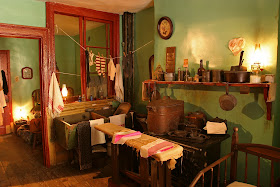America's National Park Service is turning 100 years old today. Did you know that there are twenty-two National Parks in the state of New York, with a dozen parks, trails, monuments, memorials, and historic sites in New York City itself? Here are some of our favorites:
 |
| courtesy of Wikimedia Commons |
(https://www.nps.gov/hagr/index.htm)
Built in 1802 and home to Alexander Hamilton for the last two years of his life, Hamilton Grange is one of the oldest homes left in Manhattan. With Hamilton-mania sweeping the nation, visitation has increased greatly at the house and there may be a wait for a tour, so schedule accordingly.
While we don't visit the Grange on our walking tour of Hamilton's New York, its makes a great complement to our guided exploration downtown. If you'd like to book a walk that takes your through what Manhattan would have been like during the Revolution and early Federal era, contact us at walknyc@gmail.com.
 |
| courtesy of the Lower East Side Tenement Museum |
(https://www.nps.gov/loea/index.htm)
In 1998, the independently operated Lower East Side Tenement Museum was designated a National Historic Site, four years after having been designated a National Historic Landmark. The best place to learn about the life of 19th-century European immigrants in New York (and, perhaps, in America), the museum also features one of the best New York/history-centric bookshops in the city.
 |
| courtesy of Wikimedia Commons |
(https://www.nps.gov/afbg/index.htm)
Tucked away at the corner of Elk and Duane streets (near Foley Square), the African Burial Ground actually consists of two parts: an outdoor memorial designed by Rodney Leon, and an indoor museum that is housed in the federal office building that was under construction when the burial ground was first unearthed. The most significant pre-Civil War black burial site in the north, the cemetery saw upward of 10,000 people laid to rest from the 1690s through the middle of the 18th century.
(We write about the African Burial Ground in the Delancey chapter of Footprints in New York.)
 |
| courtesy of the National Park Service |
https://www.nps.gov/cacl/index.htm
For many people, Castle Clinton is just a pit stop to pick up tickets for New York's most famous National Parks, the Statue of Liberty and Ellis Island. But it is worth your time to explore the small museum here and the various displays inside the building's perimeter. One of the oldest structures downtown, the castle variously served as a fortification, a reception hall, a theater, an immigrant landing depot, and an aquarium.
(James's recent attempt to recreate an 1866 walking tour of New York City starts at Castle Clinton -- then known as Castle Garden.)
For a full list of National Parks in New York State visit: https://www.nps.gov/state/NY/index.htm.
* * * *
|











